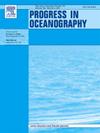The Labrador Current cold front shaping the Atlantic salmon homing migration routes from the waters off Southern Greenland to eastern North America
IF 3.6
3区 地球科学
Q1 OCEANOGRAPHY
引用次数: 0
Abstract
Atlantic salmon (Salmo salar) experienced drastic population declines from the mid-1970 s to the early 1990′s throughout their range. The survival of the salmon while at sea is considered as the main driver of these declines, even though the underlying mechanisms are poorly understood. This study aims at improving the general understanding of the ocean distribution and migration timing of sub-adult salmon returning to North America from the waters off southern Greenland that could help determine the drivers of marine mortality. We used animal biotelemetry and numerical modeling to improve our knowledge of Atlantic salmon migratory behavior. We used data from 43 North American Atlantic salmon tagged at West Greenland, of which 5 individuals migrated towards their native rivers, and developed an individual-based model to simulate homing migration from their feeding grounds in South Greenland towards the coastal areas of their native rivers. The tagged and simulated salmon exhibited similar behavior when they encountered the cold water front formed by the southward flowing Labrador Current. The salmon either crossed the Labrador Current near the Newfoundland shelf break or continued their route southward along the warmer side of the cold front. These two pathways emerged as the migration routes split where the shelf slope is less steep. This discontinuity along the shelf break leads to a highly dynamic region, a high sea surface temperature variability, and occasional breaches in the thermal front that favor on-shelf fish migration. The salmon trajectories appear to be deflected when the front temperature is 1 °C or less. The 1 °C isotherm would thus bound the thermal distribution of North American Atlantic salmon and shape the species migration routes.
拉布拉多流冷锋塑造了大西洋鲑鱼从格陵兰岛南部水域到北美东部的洄游路线
从20世纪70年代中期到90年代初,大西洋鲑鱼(Salmo salar)的种群数量急剧下降。鲑鱼在海上的生存被认为是这些下降的主要驱动因素,尽管潜在的机制尚不清楚。这项研究的目的是提高对亚成年鲑鱼从格陵兰岛南部水域返回北美的海洋分布和迁徙时间的一般理解,这可能有助于确定海洋死亡的驱动因素。我们使用动物生物遥测和数值模拟来提高我们对大西洋鲑鱼迁徙行为的了解。我们使用了43条在西格陵兰岛被标记的北美大西洋鲑鱼的数据,其中5条鲑鱼向它们的原生河流迁移,并开发了一个基于个体的模型来模拟它们从南格陵兰岛的觅食地向它们的原生河流沿海地区的洄游。标记的和模拟的鲑鱼在遇到由向南流动的拉布拉多洋流形成的冷水锋时表现出类似的行为。这些鲑鱼要么穿过纽芬兰大陆架断裂附近的拉布拉多洋流,要么沿着冷锋较温暖的一侧继续向南行进。在陆架坡度不太陡的地方,当迁徙路线分裂时,这两条路径就出现了。这种沿大陆架断裂的不连续性导致了一个高度动态的区域,海面温度的高变动性,以及热锋的偶尔断裂,有利于大陆架上的鱼类迁徙。当锋面温度为1°C或更低时,鲑鱼的轨迹出现偏转。因此,1°C等温线将限制北美大西洋鲑鱼的热分布,并决定物种的迁徙路线。
本文章由计算机程序翻译,如有差异,请以英文原文为准。
求助全文
约1分钟内获得全文
求助全文
来源期刊

Progress in Oceanography
地学-海洋学
CiteScore
7.20
自引率
4.90%
发文量
138
审稿时长
3 months
期刊介绍:
Progress in Oceanography publishes the longer, more comprehensive papers that most oceanographers feel are necessary, on occasion, to do justice to their work. Contributions are generally either a review of an aspect of oceanography or a treatise on an expanding oceanographic subject. The articles cover the entire spectrum of disciplines within the science of oceanography. Occasionally volumes are devoted to collections of papers and conference proceedings of exceptional interest. Essential reading for all oceanographers.
 求助内容:
求助内容: 应助结果提醒方式:
应助结果提醒方式:


